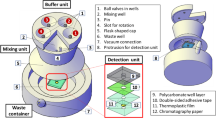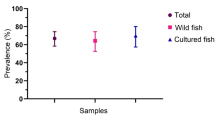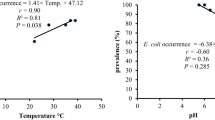Abstract
Stable-isotope probing and metagenomics were applied to study samples taken from laboratory-scale slow sand filters 0.5, 1, 2, 3 and 4 h after challenging with 13C-labelled Escherichia coli to determine the mechanisms and organisms responsible for coliform removal. Before spiking, the filters had been continuously operated for 7 weeks using water from the River Kelvin, Glasgow as their influent source. Direct counts and quantitative PCR assays revealed a clear predator–prey response between protozoa and E. coli. The importance of top-down trophic-interactions was confirmed by metagenomic analysis, identifying several protozoan and viral species connected to E. coli attrition, with protozoan grazing responsible for the majority of the removal. In addition to top-down mechanisms, indirect mechanisms, such as algal reactive oxygen species-induced lysis, and mutualistic interactions between algae and fungi, were also associated with coliform removal. The findings significantly further our understanding of the processes and trophic interactions underpinning E. coli removal. This study provides an example for similar studies, and the opportunity to better understand, manage and enhance E. coli removal by allowing the creation of more complex trophic interaction models.
Similar content being viewed by others
Log in or create a free account to read this content
Gain free access to this article, as well as selected content from this journal and more on nature.com
or
References
Abedon S . (2008). Contribution of lysogeny, pseudolysogeny and starvation to phage ecology. Bacteriophage Ecology: Population Growth, Evolution and Impact of Bacterial Viruses. Cambridge University Press: Cambridge, UK.
Alonso-Saez L, Gasol JM, Lefort T, Hofer J, Sommaruga R . (2006). Effect of natural sunlight on bacterial activity and differential sensitivity of natural bacterioplankton groups in northwestern Mediterranean coastal waters. Appl Environ Microbiol 72: 5806–5813.
Anderson M . (2001). A new method for non-parametric multivariate analysis of variance. Austral Ecol 26: 32–46.
Andrews S . (2010). FastQC a Quality Control Tool for High Throughput Sequence Data. Available at: http://www.bioinformatics.babraham.ac.uk/projects/fastqc/.
Bomo A, Hovi T, Hanssen I, Fredrik J . (2004). Bacterial removal and protozoan grazing in biological sand filters. J Environ Qual 33: 1041–1047.
Cassidy-Hanley DM . (2012). Tetrahymena in the laboratory: strain resources, methods for culture, maintenance, and storage. Methods Cell Biol 109: 237–276.
Christaki U, Vazquez-Domınguez E, Courties EC, Lebaron P . (2005). Grazing impact of different heterotrophic nanoflagellates on eukaryotic (Ostreococcus tauri) and prokaryotic picoautotrophs (Prochlorococcus and Synechococcus). Environ Microbiol 7: 1200–1210.
Clarke RK . (1993). Non-parametric multivariate analyses of changes in community structure. Aust J Ecol 18: 117–143.
Curtis TP, Mara DD, Silva SA . (1992). Influence of pH, oxygen, and humic substances on ability of sunlight to damage fecal coliforms in waste stabilization pond water. Appl Environ Microbiol 58: 1335–1343.
Danger M, Cornut J, Chauvet E, Chavez P, Elger A, Lecerf A . (2013). Benthic algae stimulate leaf litter decomposition in detritus-based headwater streams: a case of aquatic priming effect? Ecology 94: 1604–1613.
Dehority B . (1984). Evaluation of subsampling and fixation procedures used for counting rumen protozoa. Appl Environ Microbiol 48: 182–185.
Elleuche S, Pöggeler S . (2010). Carbonic anhydrases in fungi. Microbiology 156: 23–29.
Elliott M, Stauber C, Koksal F, DiGiano F, Sobsey M . (2008). Reductions of E. coli, echovirus type 12 and bacteriophages in an intermittently operated household-scale slow sand filter. Water Res 42: 2662–2670.
Feng Y, Lin X, Zhu J, Jia Z . (2011). A phototrophy-driven microbial food web in a rice soil. J Soil Sediment 11: 301–311.
Fey P, Kowal AS, Gaudet P, Pilcher KE, Chisholm RL . (2007). Protocols for growth and development of Dictyostelium discoideum. Nat Protoc 2: 1307–1316.
Fleck RA, Benson EE, Bremner DH, Day JG . (2000). Studies of free radical-mediated cryoinjury in the unicellular green alga Euglena gracilis using a non-destructive hydroxyl radical assay: a novel approach for developing protistan cryopreservation strategies. Free Radic Res 32: 157–170.
Frith MC, Hamada M, Horton P . (2010). Parameters for accurate genome alignment. BMC Bioinformatics 11: 80.
Grobe S, Petry-Hansen H, Uhl M, Flemming H . (2006). Retention of hygienically relevant microorganisms from storm water effluents by slow sand filters. Slow Sand Filtration: Recent Developments in Water Treatment Technology. John Wiley and Sons: London, UK, 474–479.
Haarhoff J, Cleasby JL . (1991). Biological and physical mechanisms in slow sand filtration. Slow Sand Filtration. American Society of Civil Engineers: New York, NY, USA, 19–68.
Haig S, Collins G, Davies RL, Dorea CC, Quince C . (2011). Biological aspects of slow sand filtration: past, present and future. Water Sci Technol 11: 468–472.
Haig S, Dorea CC, Collins G, Davies RL, Quince C . (2014a). Replicating the microbial community and water quality performance of full-scale slow sand filters in laboratory-scale filters. Water Res 61: 141–151.
Harte J, Kinzig AP . (1993). Mutualism and competition between plants and decomposers: implications for nutrient allocation in ecosystems. Am Nat 141: 829–846.
Hijnen W, Dullemont Y, Schijven J, Hanzens-Brouwer A, Rosielle M, Medema G . (2007). Removal and fate of Cryptosporidium parvum, Clostridium perfringens and small-sized centric diatoms (Stephanodiscus hantzschii) in slow sand filters. Water Res 41: 2151–2162.
Hunter MD, Price PW . (1992). Playing chutes and ladders: heterogeneity and the relative roles of bottom-up and top-down forces in natural communities. Ecology 73: 723–732.
Huson DH, Mitra S, Ruscheweyh HJ, Weber N, Schuster SC . (2011). Integrative analysis of environmental sequences using MEGAN4. Genome Res 21: 1552–1560.
Kadir K, Nelson KL . (2014). Sunlight mediated inactivation mechanisms of Enterococcus faecalis and Escherichia coli in clear water versus waste stabilization pond water. Water Res 50: 307–317.
Kavak H . (2012). Some biological parmaters in Sordaria Fimicola. Pak J Bot 44: 1079–1082.
Liu W, Au DW, Anderson DM, Lam PK, Wu RS . (2007). Effects of nutrients, salinity, pH and light: dark cycle on the production of reactive oxygen species in the alga Chattonella marina. J Exp Mar Biol Ecol 346: 76–86.
Lloyd B . (1973). The construction of a sand profile sampler: its use in the study of the vorticella populations and the general interstitial microfauna of slow sand filters. Water Res 7: 963–973.
Maynard H, Ouki S, Williams S . (1999). Tertiary lagoons: a review of removal mechanisms and performance. Water Res 33: 1–13.
Marley J, Lu M, Bracken C . (2001). A method for efficient isotopic labeling of recombinant proteins. J Biomol NMR 20: 71–75.
McCambridge J, McMeekin T . (1980). Relative effects of bacterial and protozoan predators on survival of Escherichia coli in estuarine water samples. Appl Environ Microbiol 40: 907–911.
Mikola J, Setala H . (1998). No evidence of trophic cascades in an experimental microbial-based soil food web. Ecology 79: 153–164.
Nasr A, Bekheet IA, Ibrahim R . (1968). The effect of different nitrogen and carbon sources on amino acid synthesis in Ulva, Dictyota and Pterocladia. Hydrobiologia 31: 7–16.
Nedelcu A, Miles I, Fagir A, Karol K . (2008). Adaptive eukaryote-to-eukaryote lateral gene transfer: stress-related genes of algal origin in the closest unicellular relatives of animals. J Evolution Biol 21: 1852–1860.
Neufeld J, Vohra J, Dumont MG, Lueders T, Manefield M, Friedrich MW et al. (2007). DNA stable-isotope probing. Nat Protoc 2: 860–866.
Oksanen J, Blanchet FG, Kindt R, Legendre P, Minchin PR, O’Hara RB et al. (2012). Vegan: Community Ecology Package, R package version 2.0-3.
Pace M, Cole J . (1994). Comparative and experimental approaches to top-down and bottom-up regulation of bacteria. Microb Ecol 28: 181–193.
Parry JD . (2004). Protozoan grazing of freshwater biofilms. Adv Appl Microbiol 54: 167–196.
Pernthaler J . (2005). Predation on prokaryotes in the water column and its ecological implications. Nat Rev Microbiol 3: 537–546.
Ripp S, Miller RV . (1997). The role of pseudolysogeny in bacteriophage-host interactions in a natural freshwater environment. Microbiology 143: 2065–2070.
Rosemond AD, Pringle CM, Ramírez A, Paul MJ . (2001). A test of top-down and bottom-up control in a detritus-based food web. Ecology 82: 2279–2293.
Semple KT, Cain RB . (1996). Biodegradation of phenols by the alga Ochromonas danica. Appl Environ Microbiol 62: 1265–1273.
Sul W, Park J, Quensen J, Rodrigues J, Seliger LT, Tsoi TV et al. (2009). DNA-stable-isotope probing integrated with metagenomics for retrieval of biphenyl dioxygenase genes from polychlorinated biphenyl-contaminated river sediment. Appl Environ Microbiol 75: 5501–5506.
Weber-Shirk M, Dick R . (1999). Bacterivory by a Chrysophyte in slow sand filters. Water Res 33: 631–638.
Weber KP, Legge RL . (2008). Pathogen removal in constructed wetlands. In Wetlands: Ecology, Conservation and Restoration. Nova Publishers: New York, NY, USA, pp 176–211.
Weekers PH, Bodelier PL, Wijen JP, Vogels GD . (1993). Effects of grazing by the free-living soil amoebae Acanthamoeba castellanii, Acanthamoeba polyphaga, and Hartmannella vermiformis on various bacteria. Appl Environ Microbiol 59: 2317–2319.
WHO (World Health Organization).. (2004). Water and Sanitation: Facts and Figures. Available at: http://www.who.int/water_sanitation_health/publications/factsfigures04/.
Withey S, Cartmell E, Avery L, Stephenson T . (2005). Bacteriophages potential for application in wastewater treatment processes. Sci Total Environ 339: 1–18.
Wooley J, Godzik A, Friedberg I . (2010). A primer on metagenomics. PLoS Comput Biol 6: 1–13.
Yue J, Sun G, Hu X, Huang J . (2013). The scale and evolutionary significance of horizontal gene transfer in the choanoflagellate Monosiga brevicollis. BMC Genomics 14: 729.
Zeng L, Golding I . (2011). Following cell-fate in E. coli after infection by phage lambda. J Vis Exp 1: 3363.
Acknowledgements
S-JH is supported by a Lord Kelvin/Adam Smith Research scholarship from the University of Glasgow. MS is supported by Unilever R&D, Port Sunlight, Bedington, UK. GC is supported by a European Research Council award (3C-BIOTECH; 261330). CQ is supported by an EPSRC Career Acceleration Fellowship award (EP/H003851/1). A special thanks to the GU68 Engineers Trust, Ian Scouller, Brian Robb, Tim Montgomery, Robert Boyd and Cindy Smith without whom this work would not have been possible.
Author information
Authors and Affiliations
Corresponding author
Ethics declarations
Competing interests
The authors declare no conflict on interest.
Additional information
Supplementary Information accompanies this paper on The ISME Journal website
Supplementary information
Rights and permissions
About this article
Cite this article
Haig, SJ., Schirmer, M., D'Amore, R. et al. Stable-isotope probing and metagenomics reveal predation by protozoa drives E. coli removal in slow sand filters. ISME J 9, 797–808 (2015). https://doi.org/10.1038/ismej.2014.175
Received:
Revised:
Accepted:
Published:
Issue date:
DOI: https://doi.org/10.1038/ismej.2014.175
This article is cited by
-
Microbial ecology of biofiltration used for producing safe drinking water
Applied Microbiology and Biotechnology (2022)
-
Food selectivity of anaerobic protists and direct evidence for methane production using carbon from prey bacteria by endosymbiotic methanogen
The ISME Journal (2020)
-
Streptophyta and Acetic Acid Bacteria Succession Promoted by Brass in Slow Sand Filter System Schmutzdeckes
Scientific Reports (2019)
-
Selective elimination of bacterial faecal indicators in the Schmutzdecke of slow sand filtration columns
Applied Microbiology and Biotechnology (2015)



